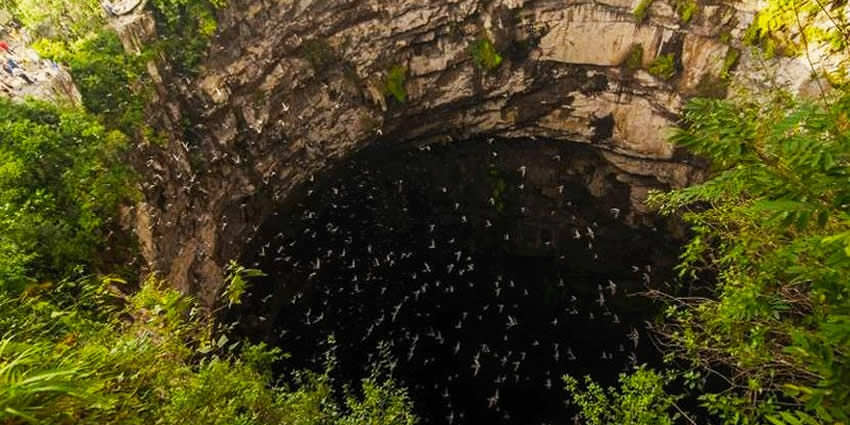
Cave of Swallows
The Cave of Swallows (“Sótano de las Golondrinas”), is an open-air pit cave.
The cave is located in San Luis Potosi. Its elliptical mouth is located on a karst slope, has a width of 49 by 62 m, is cut around the entire perimeter, and expands into a cave room approximately 303 by 135 m wide.
The Cave of Swallows is designated as a state-protected area since 1980.
This karstic cave, formed by water erosion in an impermeable fault of a limestone plain, features a conical shape with a notably narrower opening at the top than the bottom. The abyss reaches a depth of approximately 512 m.
Top opening diameter of around 60 m and a maximum bottom opening of about 300 m by 60 at its widest. It serves as a natural refuge for birds, particularly swifts (not swallows), and a type of parrot called Cotorras de Cueva.
The cave is the 2nd deepest pit in Mexico, and maybe the 11th deepest in the world.
The cave has been known to the local Huastec people since ancient times.
The cave is formed in the El Abra and Tamabra formations, limestones of middle Cretaceous age. The speleogenesis of the cave is still not fully understood, but it is the result of solution expansion along a vertical fault followed by vadose expansion.
The Spanish name for the cave is “Sótano de las Golondrinas” which means “Basement of the Swallows”.
The place got its name because of the many birds that live in holes in the walls of the cave. These are mainly white-collared swifts and green parrots, but true swallows are rare here.
Every morning, flocks of birds leave the cave, flying in concentric circles.
Birds fly gaining altitude until they reach the entrance. In the evenings, a large flock of swifts circles the entrance to the cave, and about once a minute a group of birds breaks away and heads straight for the exit.
As they cross the edge, the birds clench their wings and fall freely, spreading their wings and breaking out of their dive when they reach the height of their nests. Watching this has become popular among tourists.
Temperatures in the cave are low. Vegetation grows thickly at the mouth. The cave floor is covered with a thick layer of debris and guano.
From the floor at the bottom of the shaft, there is a series of narrow pits known as The Crevice, totaling about 140 m, which brings the total depth of the cave to 515 m.
Discovery of the Cave of Swallows
This cave was discovered in 1966, by a team of ornithologists from Texas.
Ornithologists discovered in this grave a more than eloquent example of the importance that such graves have for the bird populations of the region, by providing shelter from predators in their steep walls.
The first Mexican expedition was carried out in 1974 by the Mexica speleologist Lorenzo García Gallardo who was the first to descend. In 1978, Isabel Vivian was the first Mexican woman to descend this cave.
Despite the initial purely scientific interest, the pit soon began to attract speleologists looking for an interesting experience, and later tourists, due to the spectacular descent and views.
However, it is possible that the place was a victim of its popularity since subsequent ornithological studies have confirmed a gradual decrease in the bird population inside the grotto, perhaps due to this influx of new visitors.
Currently, the basement and other similar graves are considered biosphere reserves by the Mexican government, a status that grants them relative legal protection, while privileging the measured exploitation of the site.
Exploring the vertical abyss of the cave
Discovered in 1966 by a team of ornithologists, the cave gained popularity among cavers and tourists for its stunning descent and views. Initially a site of scientific interest, its appeal led to a decrease in bird populations.
The Mexican government designated the cave, as a biosphere reserve. Despite concerns about the impact of visitors on bird populations, the site continues to be legally protected, balancing conservation with measured exploration.
The cave is a popular vertical caving destination. Cavers anchor their ropes on the low side, where bolts have been installed in the rock and the area is clear of obstructions. Rappelling to the floor can take up to an hour.
Climbing back out may take from 40 minutes to more than 2 hours.
The Cave of Swallows is considered the world’s largest single-drop cave with 512 meters of depth. The cave is admired by spelunkers of various nationalities as one of the most beautiful vertical caves globally.
The descent into this subterranean world begins at dawn, accompanied by the mesmerizing flight of thousands of swifts and parrots. The film “Point Break” (2015) briefly references this cave and its vast dimensions.
It takes almost 10 seconds for a person without a parachute to freely fall from his mouth to the floor. The pit is popular among extreme sports enthusiasts for base jumping, who later can get out in about 10 minutes using a winch.
Let us know if this article was useful for you